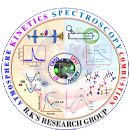Long carbon-chain framework Hydrofluoroolefin (HFOs) systems are considered to be successful alternatives to the routine Hydrofluorocarbons (HFCs). The influence of these HFOs can be understood based on their chemical interaction(s) with the atmospheric oxidants. Therefore, to better assess the impact of HFC-1225zc and HFC-1327cz on the Earth's atmosphere, kinetics was investigated with atmosphere's most powerful oxidant, OH radical, in the temperature range of 200–400 K using the CCSD(T)/cc-pVTZ//M062x/6-31+G(d,p) level of theory. Temperature dependent hindered-rotor corrected rate coefficients for the corresponding OH-addition and H-abstraction channels were determined using the dual-level direct dynamics with the Interpolated Single Point Energy method (VTST/ISPE) in conjunction with the Small-Curvature Tunneling (SCT) corrections. Among the two channels studied, addition channels played an essential role in determining the global reactivity of these HFOs. The global rate coefficients (in 10−13 cm3 molecule−1 sec−1) obtained at 298 K are; k(CF2=CHCF3+OH)=9.41 and k(CF2=CHCF2CF3+OH)=9.11 respectively. COF2, CF3CHO, CF3COCF2OH, CF3CF2CH(F)O, CF3COOH and CF3CF2COOH are the major products formed via the possible O2-NOx initiated product degradation mechanism for these HFOs. The atmospheric lifetimes for these molecules were found to be 31 and 14 days respectively. Radiative Efficiencies (REs), Global-Warming Potentials (GWPs), and Photochemical Ozone Creation Potentials (POCPs) are also reported as part of this work.
-
Call
-
E-mail
Journal Details
1. A dual level direct dynamics study for the reaction of CF2=CHCF3 (HFC-1225zc) and CF2=CHCF2CF3 (HFC-1327cz) towards OH radicals..
P. Gupta & B. Rajakumar. Chemistry , , 4827- 4838., 4
